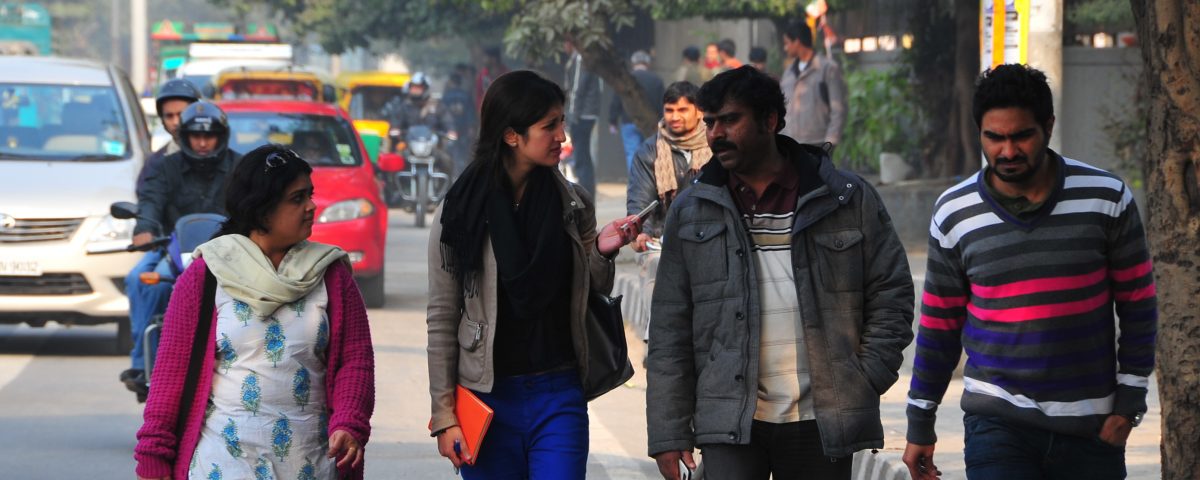
Diary of an Intern at Phuketwan in Thailand
7 January 2013
4 JMSC Students Wind Up Winter Internships in Burma
15 January 2013JMSC Student Covers Gang Rape Story in India for the New York Times

Anjani Trevdi (MJ, 2013) interviewing protestors of the gang rape. (photo: Rahul Kotwal)

Anjani Trivedi (MJ, 2013) interviewing protestors against the gang rape. (photo: Rahul Kotwal)
The purpose of internships is to show students what working in the real world of journalism is like. Anjani Trivedi, a Master of Journalism student at the JMSC, got an unprecedented look at that world while working as an intern at the New York Times New Delhi Bureau this winter: she has helped cover the gang rape of a 23-year-old medical student, a story that has made headlines around the world.
So far, almost a dozen of Trivedi’s articles about the incident and its aftermath have appeared in the Times. Here is her account of what it’s been like:
The young woman was gang-raped by six men on December 16 on a moving bus. She and her male friend were brutally assaulted by the attackers with an iron rod. As urban India was wrapped in fear, anger and shock, the girl struggled to hold onto life. Almost two weeks later, she died.
The story hit newsrooms and citizens on the morning of December 17th. Immediately, there were protests all over Delhi, which eventually spread to other big cities in India.

A lone mourner sits next to a line of candles at a protest of the rape. (photo: Anjani Trivedi)
The Indian media, notorious for sensationalizing and exaggerating, produced reams of details on the victim’s condition, but none were confirmable. At the New York Times’ New Delhi Bureau, we collected facts from verifiable and direct sources – from press conferences, police officers and doctors. Reporters from the Bureau discussed and covered different aspects of the case. This is the way most stories are approached at the bureau.
Some of our pieces, which have been more detailed and specific, have been written for India Ink, a Times blog focused on India, while other stories, about the bigger picture, have been for the newspaper itself and its international edition, the International Herald Tribune.
We reported the rape on the 18th:
“The police said the men were looking for some fun. They had been drinking, having a party, and decided to go on a joy ride. They began circling the capital in a private bus, the police said, when they spotted a couple looking for a ride home. They waved the man and woman onboard and charged them each 36 cents.
“And then, the police said, the men beat the couple with an iron rod and repeatedly raped the woman as the bus circled the city. The woman suffered severe injuries to her head and intestines and required multiple operations, local news media reported, indicators of an assault so savage that India’s capital on Tuesday was shaking with public outrage. Protesters encircled a local police station and blocked a major highway. India’s parliament erupted in angry protests and condemnation”.
As the days progressed, the victim’s condition was closely monitored, and India was searching its soul. In the newsroom, we explored questions of public transport, stronger laws and punishment.
The day after the rape, I went to speak to people using all forms of public transport around the capital city: what did they think was the issue? I reported on what people thought, a vox populi of sorts. There were conflicting views. Some were sympathetic to the harrassment woman face routinely, as expected: “If you’re a woman, you’re not safe on public buses in Delhi”.
But others put part of the blame on the women themselves. “If you get raped, it’s probably your fault”.
On another day, I visited the young woman’s home and spoke to people who knew her. I presented a profile of the victim and put a human side to it.

One of the mourners for the rape victim with protest signs. (photo: Anjani Trivedi)
In the weeks after the attack, India’s youth came out in huge numbers – protesting, marching and mourning, because this young woman could have been any one them and her story resonated with them. She was, neighbors said, a symbol of a regular, educated young woman living in a city.
A key part of covering a developing story, especially one like this that has made international headlines, is staying on top of every element, every character, every detail. We have to make sure the details are put into the context of the entire story as it develops.
Today, I spoke to the lawyers for the accused rapists and reported that three of them are pleading not guilty.
Tomorrow, we will see how the story develops.
